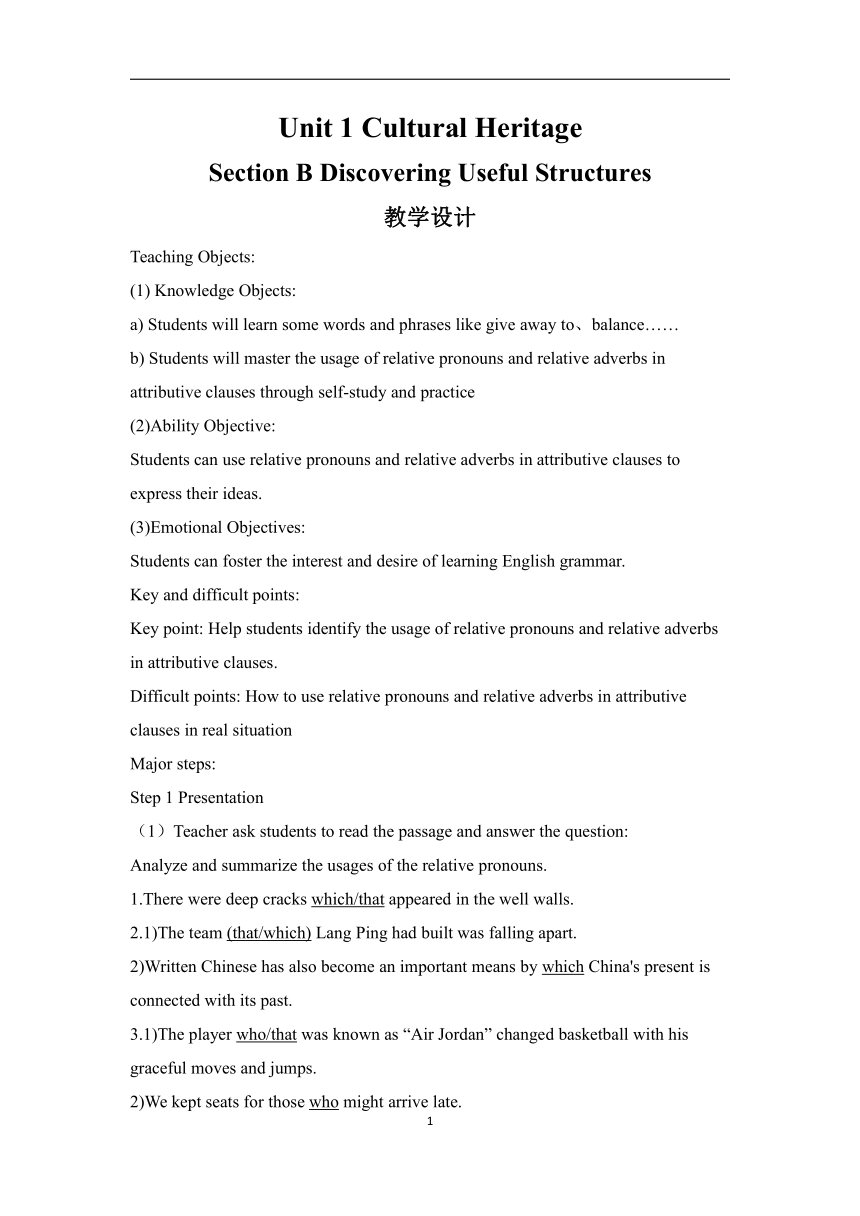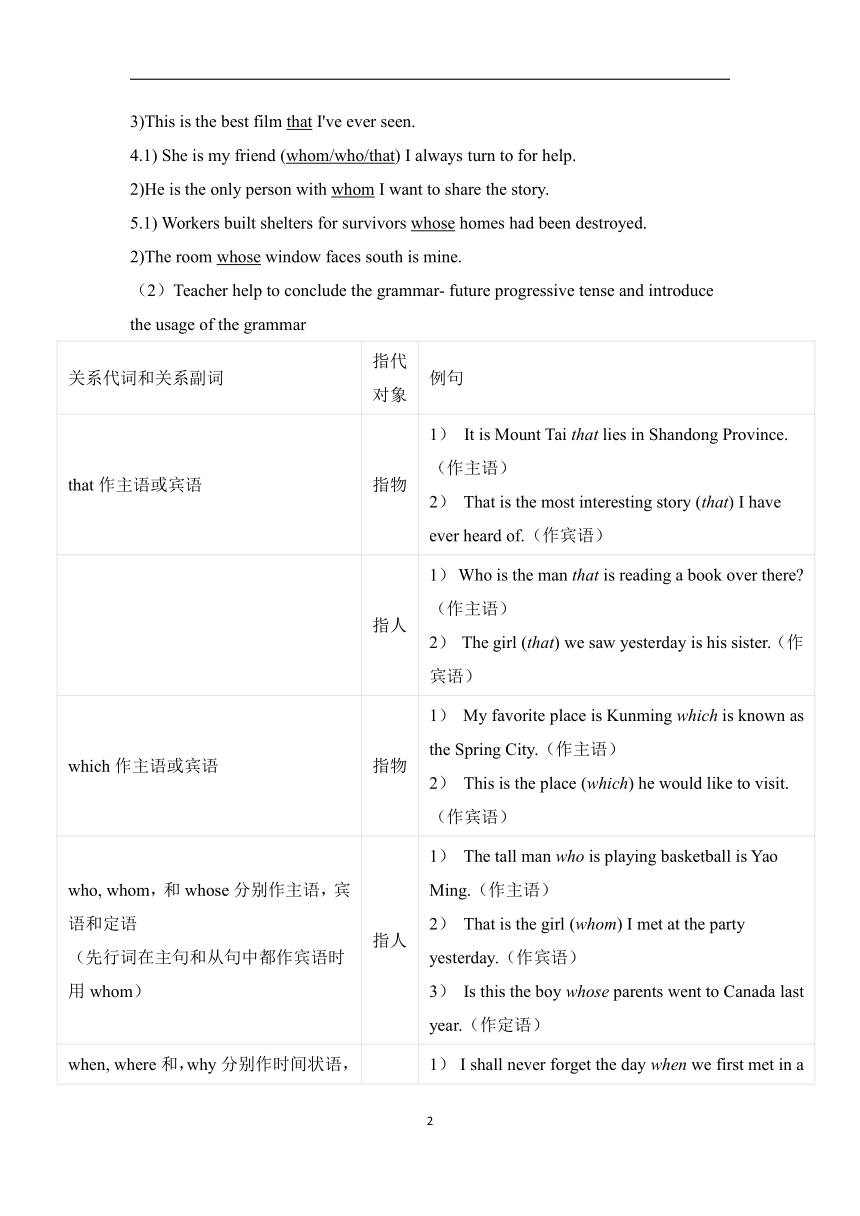人教版(2019)必修第二册Unit 1 Cultural Heritage Section B Discovering Useful Structures 教案
文档属性
| 名称 | 人教版(2019)必修第二册Unit 1 Cultural Heritage Section B Discovering Useful Structures 教案 |  | |
| 格式 | docx | ||
| 文件大小 | 24.2KB | ||
| 资源类型 | 教案 | ||
| 版本资源 | 人教版(2019) | ||
| 科目 | 英语 | ||
| 更新时间 | 2022-11-15 14:29:29 | ||
图片预览


文档简介
Unit 1 Cultural Heritage
Section B Discovering Useful Structures
教学设计
Teaching Objects:
(1) Knowledge Objects:
a) Students will learn some words and phrases like give away to、balance……
b) Students will master the usage of relative pronouns and relative adverbs in attributive clauses through self-study and practice
(2)Ability Objective:
Students can use relative pronouns and relative adverbs in attributive clauses to express their ideas.
(3)Emotional Objectives:
Students can foster the interest and desire of learning English grammar.
Key and difficult points:
Key point: Help students identify the usage of relative pronouns and relative adverbs in attributive clauses.
Difficult points: How to use relative pronouns and relative adverbs in attributive clauses in real situation
Major steps:
Step 1 Presentation
(1)Teacher ask students to read the passage and answer the question:
Analyze and summarize the usages of the relative pronouns.
1.There were deep cracks which/that appeared in the well walls.
2.1)The team (that/which) Lang Ping had built was falling apart.
2)Written Chinese has also become an important means by which China's present is connected with its past.
3.1)The player who/that was known as “Air Jordan” changed basketball with his graceful moves and jumps.
2)We kept seats for those who might arrive late.
3)This is the best film that I've ever seen.
4.1) She is my friend (whom/who/that) I always turn to for help.
2)He is the only person with whom I want to share the story.
5.1) Workers built shelters for survivors whose homes had been destroyed.
2)The room whose window faces south is mine.
(2)Teacher help to conclude the grammar- future progressive tense and introduce the usage of the grammar
关系代词和关系副词 指代对象 例句
that作主语或宾语 指物 1) It is Mount Tai that lies in Shandong Province.(作主语) 2) That is the most interesting story (that) I have ever heard of.(作宾语)
指人 1) Who is the man that is reading a book over there (作主语) 2) The girl (that) we saw yesterday is his sister.(作宾语)
which作主语或宾语 指物 1) My favorite place is Kunming which is known as the Spring City.(作主语) 2) This is the place (which) he would like to visit.(作宾语)
who, whom,和whose分别作主语,宾语和定语 (先行词在主句和从句中都作宾语时用whom) 指人 1) The tall man who is playing basketball is Yao Ming.(作主语) 2) That is the girl (whom) I met at the party yesterday.(作宾语) 3) Is this the boy whose parents went to Canada last year.(作定语)
when, where和,why分别作时间状语,地点状语和原因状语 1) I shall never forget the day when we first met in a park.(作时间状语) 2) My favorite city is Beijing where I can visit the Great Wall.(作地点状语) 3) This is the reason why you should leave.(作原因状语)
注:that和which都可指物,且在句中都可作主语和宾语,多数情况下可以互换。但在以下情况中,关系代词只能用that,不能用which。
1.先行词既指人又指物。
2.先行词被all, every, any, little, only, much, no等不定代词修饰时,或先行词本身是all, much, everything, anything, no以及no构成的复合词。
3.先行词被形容词最高级或序数词修饰。
4.先行词被the only, the very, the last, the same修饰。
5.有两个或两个以上分别表示人和物的先行词。
6.主句以who, what, which开头的特殊疑问句。
关系代词和关系副词的判定方法:
关系副词和关系代词的选择是根据先行词在定语从句中做的成分。若是做状语,则用关系副词或“介词+which”; 若是做主语和宾语,则用关系代词。
“介词+关系代词”引导的定语从句:
关系代词做介词的宾语时,为了使关系代词与先行词的关系词更加紧凑,可以将从句中的介词提前到关系代词之前,形成“介词+关系代词”结构。该结构中的关系代词可用which或whom;介词可以依据从句中的谓语的搭配、与先行词的搭配或句子意义来确定。
Is this the car for which you paid a high price
这是你画大价钱买的车吗?(根据从句中谓语动词pay的搭配来定)
注:(1)有些“动词+介词”短语,如 look for, look after, call on等不可拆开而把介词置于关系代词之前。
(2)有时候“介词+关系代词”前还会有名词、代词等。
The river, the bank of which are covered with trees, flows to the seas.
定语从句需要注意的问题:
1. as引导限制性定语从句时,常用于下列句式中:
such+名词+as..…像……一样的;the same+名词+as.…
和……同样的。
2.当先行词是time时,若time表示“次数”,应用that引导定语从句,并且that可以省略;若time表示“一段时间”
讲,应用when或“at/during+which”引导定语从句。
This is the second time(that)the president has visited the country.
这是这位总统第二次访问这个国家。
This is at a time when/during which there were no radios,no telephones or no TV sets.
这是在一个没有收音机,没有电话,也没有电视机的时代。
3.定语从句中的主谓一致
当关系代词在从句中做主语时,从句中谓语动词的数
原则上要与先行词保持一致,但要注意以下几点:先行词是
“one of+复数名词”结构时,关系代词引导的定语从句中的谓语动词一般用复数形式;但如有the very,the only,the first,the last,the right 等修饰one时,谓语动词用单数。
This is one of the most interesting questions that have been asked.
这是被问过的最有意思的问题之一。
4. stage表示“阶段”,occasion表示“场合”,后接的定语从句既可接when也可接where。
The baby has reached the stage when he can stand up.
婴儿到了能站立的阶段了。
Step 2 Practice
Students finish the exercise on page 6.Teacher will ask them to check the right answer on PPT.
Step 3 Production
Group task: Students will be divided in to several groups. Then share the results with whole class. Students are encouraged to use the grammar when talking.
(Justification: Students will learn to use the grammar in a proper way through those activities.)
Step 4 Summary and homework
1. Summary
Students should act as an assistant to conclude what they have learned in this class, and then the teacher will make a summary together with students.
(Justification: Reviewing the important knowledge in this lesson can deepen students' impression and form good study habits)
2. Homework
Finish the exercise in PPT.
(Justification: Retelling can help students sort out the course content, and the exercise can help students master the grammar better.)
2
Section B Discovering Useful Structures
教学设计
Teaching Objects:
(1) Knowledge Objects:
a) Students will learn some words and phrases like give away to、balance……
b) Students will master the usage of relative pronouns and relative adverbs in attributive clauses through self-study and practice
(2)Ability Objective:
Students can use relative pronouns and relative adverbs in attributive clauses to express their ideas.
(3)Emotional Objectives:
Students can foster the interest and desire of learning English grammar.
Key and difficult points:
Key point: Help students identify the usage of relative pronouns and relative adverbs in attributive clauses.
Difficult points: How to use relative pronouns and relative adverbs in attributive clauses in real situation
Major steps:
Step 1 Presentation
(1)Teacher ask students to read the passage and answer the question:
Analyze and summarize the usages of the relative pronouns.
1.There were deep cracks which/that appeared in the well walls.
2.1)The team (that/which) Lang Ping had built was falling apart.
2)Written Chinese has also become an important means by which China's present is connected with its past.
3.1)The player who/that was known as “Air Jordan” changed basketball with his graceful moves and jumps.
2)We kept seats for those who might arrive late.
3)This is the best film that I've ever seen.
4.1) She is my friend (whom/who/that) I always turn to for help.
2)He is the only person with whom I want to share the story.
5.1) Workers built shelters for survivors whose homes had been destroyed.
2)The room whose window faces south is mine.
(2)Teacher help to conclude the grammar- future progressive tense and introduce the usage of the grammar
关系代词和关系副词 指代对象 例句
that作主语或宾语 指物 1) It is Mount Tai that lies in Shandong Province.(作主语) 2) That is the most interesting story (that) I have ever heard of.(作宾语)
指人 1) Who is the man that is reading a book over there (作主语) 2) The girl (that) we saw yesterday is his sister.(作宾语)
which作主语或宾语 指物 1) My favorite place is Kunming which is known as the Spring City.(作主语) 2) This is the place (which) he would like to visit.(作宾语)
who, whom,和whose分别作主语,宾语和定语 (先行词在主句和从句中都作宾语时用whom) 指人 1) The tall man who is playing basketball is Yao Ming.(作主语) 2) That is the girl (whom) I met at the party yesterday.(作宾语) 3) Is this the boy whose parents went to Canada last year.(作定语)
when, where和,why分别作时间状语,地点状语和原因状语 1) I shall never forget the day when we first met in a park.(作时间状语) 2) My favorite city is Beijing where I can visit the Great Wall.(作地点状语) 3) This is the reason why you should leave.(作原因状语)
注:that和which都可指物,且在句中都可作主语和宾语,多数情况下可以互换。但在以下情况中,关系代词只能用that,不能用which。
1.先行词既指人又指物。
2.先行词被all, every, any, little, only, much, no等不定代词修饰时,或先行词本身是all, much, everything, anything, no以及no构成的复合词。
3.先行词被形容词最高级或序数词修饰。
4.先行词被the only, the very, the last, the same修饰。
5.有两个或两个以上分别表示人和物的先行词。
6.主句以who, what, which开头的特殊疑问句。
关系代词和关系副词的判定方法:
关系副词和关系代词的选择是根据先行词在定语从句中做的成分。若是做状语,则用关系副词或“介词+which”; 若是做主语和宾语,则用关系代词。
“介词+关系代词”引导的定语从句:
关系代词做介词的宾语时,为了使关系代词与先行词的关系词更加紧凑,可以将从句中的介词提前到关系代词之前,形成“介词+关系代词”结构。该结构中的关系代词可用which或whom;介词可以依据从句中的谓语的搭配、与先行词的搭配或句子意义来确定。
Is this the car for which you paid a high price
这是你画大价钱买的车吗?(根据从句中谓语动词pay的搭配来定)
注:(1)有些“动词+介词”短语,如 look for, look after, call on等不可拆开而把介词置于关系代词之前。
(2)有时候“介词+关系代词”前还会有名词、代词等。
The river, the bank of which are covered with trees, flows to the seas.
定语从句需要注意的问题:
1. as引导限制性定语从句时,常用于下列句式中:
such+名词+as..…像……一样的;the same+名词+as.…
和……同样的。
2.当先行词是time时,若time表示“次数”,应用that引导定语从句,并且that可以省略;若time表示“一段时间”
讲,应用when或“at/during+which”引导定语从句。
This is the second time(that)the president has visited the country.
这是这位总统第二次访问这个国家。
This is at a time when/during which there were no radios,no telephones or no TV sets.
这是在一个没有收音机,没有电话,也没有电视机的时代。
3.定语从句中的主谓一致
当关系代词在从句中做主语时,从句中谓语动词的数
原则上要与先行词保持一致,但要注意以下几点:先行词是
“one of+复数名词”结构时,关系代词引导的定语从句中的谓语动词一般用复数形式;但如有the very,the only,the first,the last,the right 等修饰one时,谓语动词用单数。
This is one of the most interesting questions that have been asked.
这是被问过的最有意思的问题之一。
4. stage表示“阶段”,occasion表示“场合”,后接的定语从句既可接when也可接where。
The baby has reached the stage when he can stand up.
婴儿到了能站立的阶段了。
Step 2 Practice
Students finish the exercise on page 6.Teacher will ask them to check the right answer on PPT.
Step 3 Production
Group task: Students will be divided in to several groups. Then share the results with whole class. Students are encouraged to use the grammar when talking.
(Justification: Students will learn to use the grammar in a proper way through those activities.)
Step 4 Summary and homework
1. Summary
Students should act as an assistant to conclude what they have learned in this class, and then the teacher will make a summary together with students.
(Justification: Reviewing the important knowledge in this lesson can deepen students' impression and form good study habits)
2. Homework
Finish the exercise in PPT.
(Justification: Retelling can help students sort out the course content, and the exercise can help students master the grammar better.)
2
